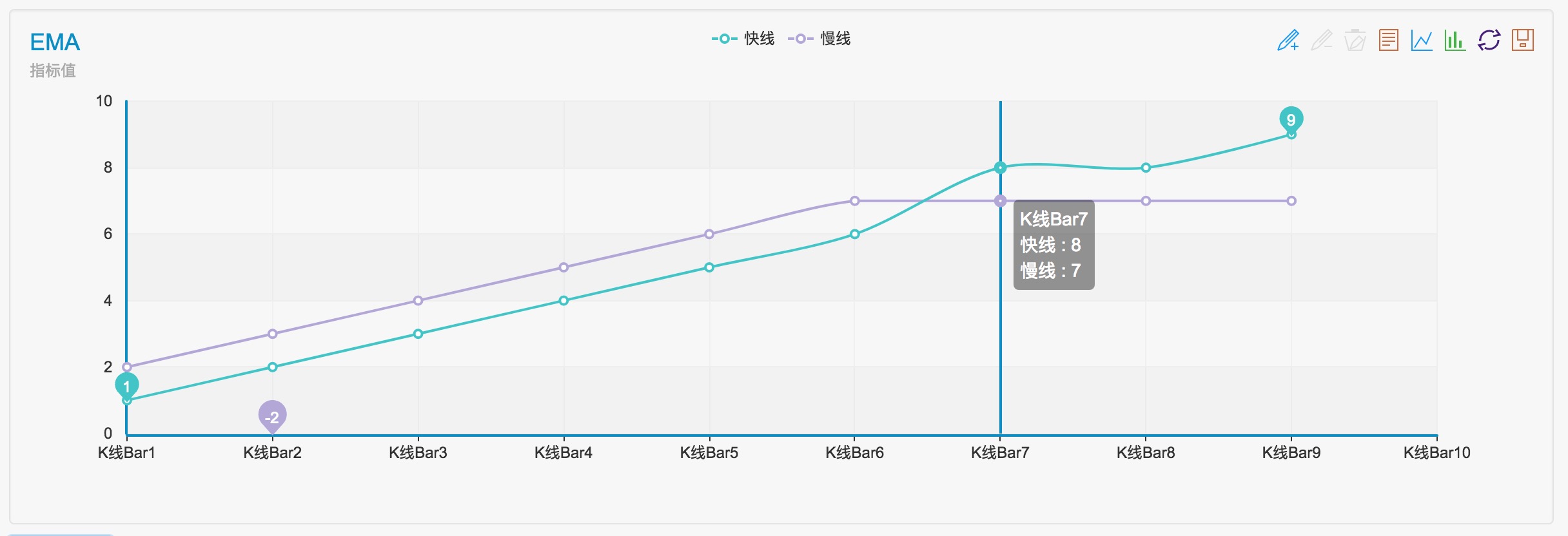Built-in function_Cross analysis and instructions
Author: The Little Dream, Created: 2017-10-11 19:50:44, Updated: 2021-11-05 16:15:56Built-in function_Cross analysis and instructions
The _Cross function in the global function array in the API documentation is used to calculate the cross state of two pointer lines
-
The function implements code similar to the following:
It's important to note that
arr1It is defined as a fast-track indicator array.arr2When defined as a slow-line indicator array,_CrossThe function returns a positive value, i.e. according to the document.正数为上穿周期, 负数表示下穿的周期, 0指当前价格一样I know, right now.arr1Get up there.arr2It's been n cycles, at which point the fast line crosses the slow line to represent the golden fork. The same._CrossIf the function returns a negative number, it is a dead fork.If defined
arr1For the slow-line indicator array,arr2For the fast-line indicator array, the opposite is true._CrossThe function returns a positive value for the dead fork._CrossThe function returns a negative value representing the gold fork.
// 返回上穿的周期数,正数为上穿周数,负数表示下穿的周数,0指当前价格一样
$.Cross = function(arr1, arr2) { // 参数个数为2个,从参数名可以看出,这两个参数应该都是数组类型,数组就
// 好比是在X轴为数组索引值,Y轴为指标值的坐标系中的线段,该函数就是判断两条线的 交叉情况
if (arr1.length !== arr2.length) { // 首先要判断比较的两个数组长度是否相等
throw "array length not equal"; // 如果不相等抛出错误,对于不相等的指标线无法判断相交
}
var n = 0; // 声明变量n用来记录交叉状态,初始0,未相交
for (var i = arr1.length-1; i >= 0; i--) { // 遍历数组arr1,遍历顺序为从最后一个元素向前遍历
if (typeof(arr1[i]) !== 'number' || typeof(arr2[i]) !== 'number') { // 当arr1或者arr2任何一个数组为非数值类型(即无效指标)时,跳出遍历循环
break; // 跳出循环
}
if (arr1[i] < arr2[i]) { // 如果arr1小于arr2则n--,会记录开始时arr1、arr2的相对状态,(即开始时n会根据arr1[i]、arr2[i]相对大小自行调整,一旦出现另一种和n状态相反的arr1[i]、arr2[i]大小关系,即发生了两条线交叉。)
if (n > 0) {
break;
}
n--;
} else if (arr1[i] > arr2[i]) { // 如果arr1大于arr2则n++
if (n < 0) {
break;
}
n++;
} else { // arr1[i] == arr2[i],则立即跳出
break;
}
}
return n; // 返回n值,代表已经交叉了多少周期,0即指标值相等
};
-
So we simulate a set of data to be fed into this parameter and see what happens.
var arr1 = [1,2,3,4,5,6,8,8,9] // 快线指标
var arr2 = [2,3,4,5,6,7,7,7,7] // 慢线指标
function main(){
Log("_Cross(arr1, arr2) : ", _Cross(arr1, arr2))
Log("_Cross(arr2, arr1) : ", _Cross(arr2, arr1))
}

You can see that the result is 3, 3, 3.

As can be seen in the diagram, the position of the intersection occurs before the three K-line columns.
- Submitted Bug: An interaction button without a default parameter value when creating a policy failed to save
- Can the retargeting system select other currencies?
- Please translate the buy plan page
- Bitfinex has three markets, how do you get the robot to choose?
- Options from a dynamic perspective are a win-win
- Bitfinex counter-measurement and counter-measurement currency units are inconsistent
- How do you view the effectiveness of the backsliding and gold forks?
- Bithumb received account information in error
- Feature request : please add support for JavaScript like console for ᴀᴘɪ access
- How do you make gold forks?
- “Plan expired” while I never bought a plan…
- How do we get data from decentralized exchanges?????
- Digital currency price monitoring analysis real-time analysis Bitcoin and Bitfinex failed to operate successfully
- Poloniex has reported an error?Error: (Exchange_Register): platformId: 27, currency: BTC_ETC, Msg: Peroid does not support Register FILE: 803 reg FILE:1264
- How to get the serial number of a specific exchange?
- But we have to look at it from a different perspective.
- In the review, did the yield curve not include the cost of the purchase?
- Catching insects, predicting the earnings, the commentary in the questionnaire is wrong
- Talk about how to optimize the parameters of several programmatic trading models.
- Please teach me how to quantify the inventor's drawing, where the horizontal coordinates are not the time axis, but rather a column graph or a folded graph of numbers.
alphaStrategy00XSo if you don't have a cross, you should return 0.
And the cabbage.What if we cross back and forth?
The Little DreamWell, let's think about that.
alphaStrategy00XThank you for your reply! I mean, returning 0 is more reasonable, right?
The Little DreamWhat's up? var arr1 = [1, 2, 3, 4, 5, 6, 8, 8,9] // the fast-line indicator var arr2 = [2, 3, 4, 5, 6, 7, 7, 7] // the indicator of the slow line function main (()) { Log (("_Cross ((arr1, arr2) ": ", _Cross ((arr1, arr2)) Log (("_Cross ((arr2, arr1) ": ", _Cross ((arr2, arr1)) I'm not sure. What's up? You can use this to run a set of non-crossing arrays. I'm not going to return 0.
The Little DreamOnly the most recent cross-section is detected, and source code analysis can tell.